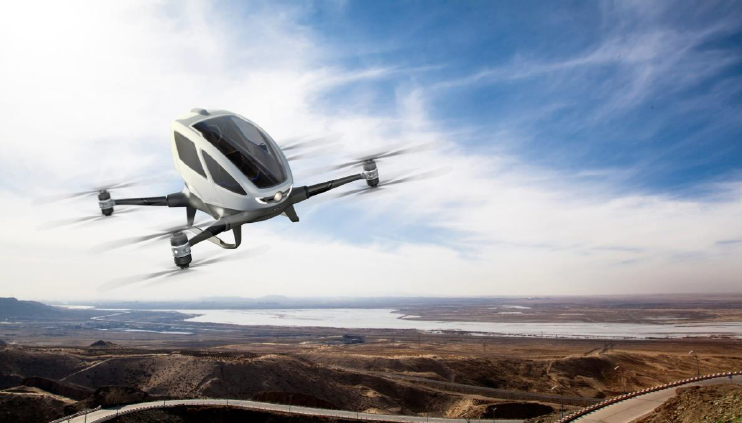
Marisol Alonso Hernandez
Marisol is a senior at Alvernia University studying Electrical Engineering.
For decades, humans have tried to explore every inch of the ocean and as much as they can in the universe. Since then, only a small percentage of the ocean floor has been explored, and we have never gone outside of our solar system, let alone another planet. Yes, we have been to the moon, but surely that is not the best we can do. Exploration has proved to be extremely difficult as we are not immune to every disease, or indestructible to the intense water pressure in the ocean, or the lack of oxygen in space. We have our limits. But what if there was something that can go beyond what we humans can – something that will not get tired, can withstand more obstacles, and can make rational decisions based off of data?
Artificial intelligence has become one the biggest technological advancements of 2023 and now in 2024, it is a complex and effective software that can create original pieces of work such as images, writings, and code. It is software created by humans, but it can learn on its own from being fed data. It can surf the web for information, compute a math problem that can take someone up to hours to complete with a step-by-step process as to how it arrived there, and it can also create lines of code ready to be implemented into a system – all within a matter of seconds. There are hundreds of ways we can use AI, so what is to say we cannot use it to expand our exploration tactics.
The ocean is a vast and mysterious place that only about 26% of the ocean floor has been mapped and about 10% of marine life has been identified. Considering that about 70% of Earth is water, this shows how little we actually know about the ocean. There are hundreds of species yet to be found but humans can only go so far. Gathering data on marine life can be extremely difficult as we cannot breathe underwater or animals may react differently when an unknown species is following them. Not only do we need to worry about marine life but it is extremely dark, intolerably cold, there are harsh chemicals, and the water pressure does not make things any better. This is when we can take a step back and let AI technology handle tasks beyond our capabilities.
According to the Woods Hole Oceanographic Institution (WHOI), a new robot they have created, CUREE, with AI will be fed millions of pictures, videos, and data regarding the different behaviors of marine life and will follow a certain species when told to do so by the users. This can potentially be taken a step further if the AI can recognize a new species and automatically follow it and capture data on its own. The WHOI robot can also be helpful when exploring volcanoes and underwater trenches. With future improvements, it may be able to gather samples based off of previous data. The best part about doing this is that we can make these robots as small and marine friendly as possible to not scare away any potential new species we encounter.
Another company called the Monterey Bay Aquarium Research Institute (MBARI) is approaching things differently, they are known for their research in the deep sea, they say “over the past 35 years, MBARI has recorded nearly 28,000 hours of deep-sea video and collected more than 1 million deep-sea images.” This is an enormous amount of data so they use AI to help process and annotate each piece of data. However, autonomous underwater vehicles (AUV) seem to be the most popular.
Autonomous underwater vehicles (AUV’s) have sonar and acoustic sensors that can identify marine life based on their movements and behaviors. This is helpful as we can now identify multiple species at once without having to memorize or refer back to a list of species. Humans can only hold so much data in their brains but AI can hold more and recite it back at a faster rate. More of these AUV’s are being made with hopes of exploring and accurately mapping out the deep sea. It allows us to explore in more remote areas such as small caves or areas that are known to have toxic chemicals like in the “Hadal Zone” where scientists have found species containing prominent levels of PCBs and PBDEs. While these are signs of how deep the human footprint goes, it raises the question on how toxic or polluted the ocean is starting to become. Exploring areas humans cannot is a huge advantage but the bigger picture here is that these vehicles can map underwater terrain with high quality images and can track coral reefs, caves, trenches, and volcanoes all while relaying data back to scientists. We can take this a step further by using AI to show how most of the geography in the ocean was formed by tracking waves, tides, pressure in the ocean, and currents. Using these vehicles in the ocean allows us to explore the ocean faster and more efficiently than ever before.
Exploring our oceans is already difficult, exploring space almost seems impossible. Humans are not made to survive in space or even on another planet. The gravity, air, gases, and temperature in the rest of the solar system is not ideal for human survival, so the only way to know what is out there is to create something to find out for us.
Much like exploring the sea, we can use AI to explore outer space. Currently NASA has created the James Webb telescope, it is the largest and most advanced telescope humans have created. The purpose of this telescope is to scope as much of the universe as it can to find out our origin and prove certain theories such as The Big Bang theory. It is so advanced it can take high resolution images through dust clouds and will even take pictures outside of our solar system. To interpret the data the James Webb telescope sends over to NASA, they use AI software to help analyze the photographs the telescope takes and help classify them. Before the James Webb telescope, the Kepler telescope was tasked to find exoplanets across our universe by identifying light curves by stars and using changes in brightness. It uses AI to find planets with the most promising signs of life, and the planets closest to the characteristics of Earth. It has found billions of planets and NASA even states that there may be more planets than stars in the universe. AI is essential for analyzing data in the universe because it analyzes it in real time without having to wait for data to come back to earth. In space the connection from the telescopes to earth can have delayed time and need constant supervision; with AI the telescopes can act on their own until human intervention is needed.
Not only is NASA using AI for advanced telescopes, but it is also using it for the Curiosity Mars Rover. Curiosity gained popularity when people found out the Rover “sings” itself happy birthday every year alone on Mars. However, curiosity can do much more like its main purpose, which is to investigate Mars collecting samples, and map out the geography. It will analyze the samples it “sees” and will then determine which images should be sent back. Curiosity uses AI to travel around Mars by planning routes and avoiding obstacles that could potentially damage the rover. The work that Curiosity is doing is for a much bigger plan in our future, as mars is the closest planet to us that mimics some of the earth’s qualities. Earth and Mars are almost the same size and Mars has shown signs of having water in the past. Nasa has been planning to travel to Mars for years now and they have planned their mission as early as 2030’s! The Robonaut created by NASA is another way AI can be implemented into robots to help make life easier in space.
The Robonaut is a robotic astronaut that NASA has been working on to assist astronauts in space by doing tasks that are too dangerous for humans such as ship repairs inside and outside the spacecraft. It can learn new tasks and recall them at high speeds for any situation and is more flexible and faster than the average human. The Robonaut project began in 1999 and since then there have only been two models which engineers are still improving. They have made the robots appear as humans adding in legs, a torso, a head, and giving the machine hands and fingers to perform jobs as humans would. The Robonaut was created and advanced to provide safer and easier missions in outer space, there is no doubt that in time this robot will be so advanced that it could potentially be the most essential piece to every mission.
AI is a crucial part in the advancement of human exploration because it can do so much that we cannot. It can analyze and track data as we instruct it to, react to real time scenarios, and recall data at high speeds. AI implemented in a robotic system is even more effective as it can venture into areas we cannot like the ocean and outer space. AI is definitely the future and it is exciting to see how we will use it to explore the world and universe around us!
WORKS REFERENCED
Did you know: Can ai help us explore the ocean?. Woods Hole Oceanographic Institution. (2023, May 23). https://www.whoi.edu/know-your-ocean/did-you-know/can-ai-help-us-explore-the-ocean/
How much of the ocean has been explored?. How much of the ocean has been explored? : Ocean Exploration Facts: NOAA Office of Ocean Exploration and Research. (n.d.). https://oceanexplorer.noaa.gov/facts/explored.html#:~:text=As%20of%20June%202024%2C%2026.1,the%20seafloor%20in%20greater%20detail.
Lonely curiosity rover sings ‘happy birthday’ to itself on Mars – The Washington Post. (n.d.). https://www.washingtonpost.com/news/the-switch/wp/2013/08/06/lonely-curiosity-rover-sings-happy-birthday-to-itself-on-mars/
L, P. (n.d.-a). ABYSS SCUBA DIVE. How much of the Ocean is explored and why we’re just scratching the surface. https://www.abyss.com.au/en/blog/viewpost/648/how-much-of-the-ocean-is-explored-and-why-were-just-scratching-the-surface
NASA. (2023a, September 26). About robonaut. NASA. https://www.nasa.gov/robonaut2/what-is-a-robonaut/
NASA. (2023, September 26). Humans to Mars. NASA. https://www.nasa.gov/humans-in-space/humans-to-mars/
NASA. (n.d.-a). Kepler / K2 – Nasa Science. NASA. https://science.nasa.gov/mission/kepler/
NASA. (n.d.-b). Mars Science Laboratory: Curiosity rover – NASA science. NASA. https://science.nasa.gov/mission/msl-curiosity/
NASA. (n.d.). Webb Image release- Webb Space Telescope GSFC/NASA. NASA. https://webb.nasa.gov/
Network, M. (2024, May 15). AI and Autonomous Ocean Exploration: Mapping the Deep Sea. Medium. https://megasisnetwork.medium.com/ai-and-autonomous-ocean-exploration-mapping-the-deep-sea-b3e527c02f0e#:~:text=AI%2Dpowered%20AUVs%20and%20robotic,of%20remote%20and%20inaccessible%20regions.
Team, M. (n.d.). Unlocking the power of AI for Ocean Exploration – Mbari Annual Report: 2022. MBARI Annual Report. https://annualreport.mbari.org/2022/story/unlocking-the-power-of-ai-for-ocean-exploration
Tillman, N. T. (2018, August 18). Water on mars: Exploration & evidence. Space.com. https://www.space.com/17048-water-on-mars.html
Watson, T. (2017, February 13). Staggering level of toxic chemicals found in creatures at the bottom of the sea, scientists say. USA Today. https://www.usatoday.com/story/news/2017/02/13/scientists-deep-sea-creatures-full-toxic-chemicals/97846814/



